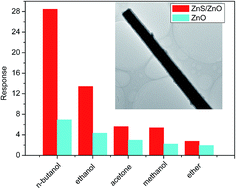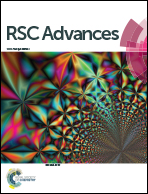ZnO@ZnS core/shell microrods with enhanced gas sensing properties†
Abstract
One-dimensional ZnO@ZnS core/shell microrods (MRs) were successfully synthesized by a facile two-step hydrothermal route, employing the low-cost inorganic salt Na2S as a sulfurizing agent. The sulfurizing time plays an important role in the growth of ZnS shells. The thickness of the ZnS shell could be adjusted by controlling the sulfurizing time. This facile surface sulfidation strategy might provide an opportunity for preparing other semiconductor metal oxide-sulfide core/shell nanostructures for a wide range of applications. For investigating the gas sensor application of the prepared ZnO@ZnS core/shell MRs, several common reductive volatile organic pollutants (VOPs) (n-butanol, ethanol, acetone, methanol and ether) were used as the probe gases for the gas sensing measurements. Due to the distinctively core/shell MR heterostructure and the heterojunction action between the ZnO core and the ZnS shell, the ZnO@ZnS core/shell MR sensor exhibited excellent gas sensing performance including high response, short response and recovery times, and good reproducibility to these VOPs, as well as much enhanced gas sensing performance compared with the bare ZnO MR sensor, demonstrating the potential application as gas sensors. It is believed that the current ZnO@ZnS core/shell MRs will also offer potential applications in other fields such as photocatalysis, electrical devices and optical devices.


 Please wait while we load your content...
Please wait while we load your content...